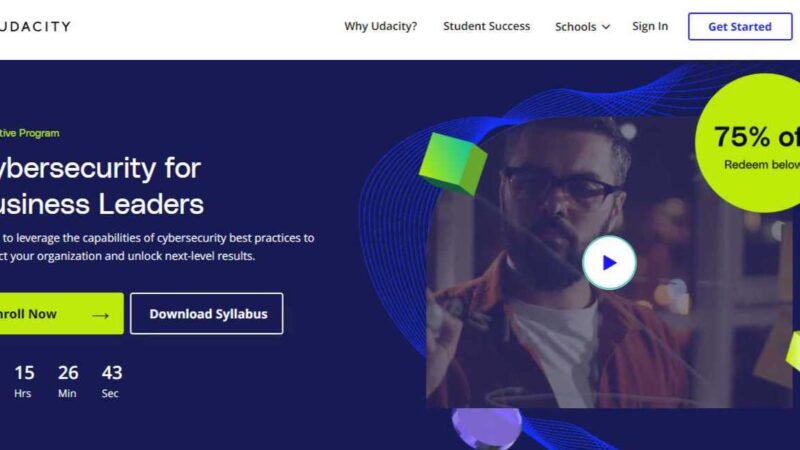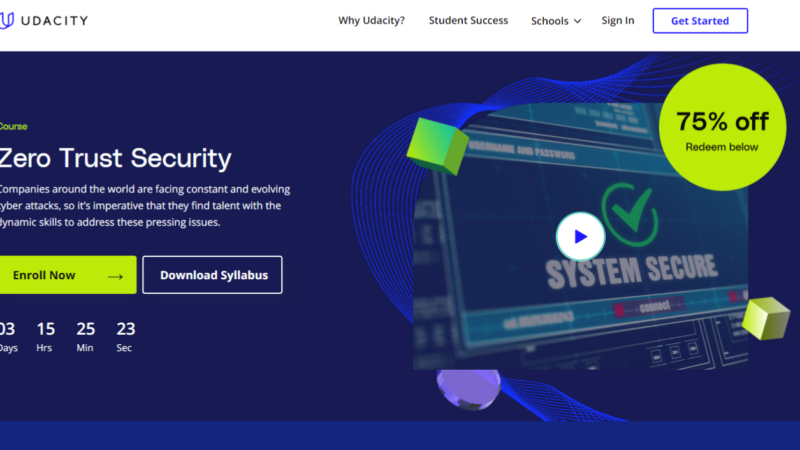Udacity Security Engineer Nanodegree Review

These days, everything is online. Though it’s convenient, it’s risky and companies are having a hard time keeping their systems secure. They need a new plan to protect them from cyberattacks and that’s where the skills of a security engineer come in handy. Jumping in and learning what it takes to break into a career as a security engineer, you can score the job of your dreams and work with some of the most sought-after companies in the world.
Of course, you’ll need a way to get those skills, which is where Udacity comes in. Their Security Engineer Nanodegree is filled with useful information but, is it enough to land a job? In this review, we’ll take a look, helping you decide if it’s worth it.
About Udacity
Udacity is an online academy that specializes in all things IT. They have a great reputation, especially after teaming up with many of the top tech companies. Though they’ve experienced decades of success, they too had to start from somewhere. Their beginnings were humble and sought to extend education to everyone, no matter where in the world they were. Two Stanford University professors teamed up to launch the first course, followed by many others that introduced computer science topics. Though it’s nowhere on the scale that it is today, Udacity started off with a bang and grew more and more every year.
Nanodegree Extras
Flexible Learning
One of the best things about learning with Udacity is the fact that you can enjoy flexible learning. That means that you can log in anytime and from anywhere, taking your work with you wherever you go. Take all the time you need and get in and get done with courses when you need to.
Hands-On Projects
Throughout each nanodegree, you’ll find small projects that are meant to help you apply your knowledge. Some of these were made in collaboration with top-tier companies, teaching the most up-to-date techniques used in the field.
A Technical Mentor
Just in case anything happens, you’ll have a technical mentor to help you out. You can contact them any time day or night to get help or just a boost to keep you on track.
Career Services
Schedule a mock interview with career services to get prepared for your big day. Or, clean up your social media pages so that your future employers don’t find anything suspicious. Career services will also help you with your portfolio, making sure that it’s ready to send out.
A-List Instructors
When Udacity chooses its instructors, they search far and wide to get the best of the best. All instructors that lead courses have academic and professional careers worth bragging about. They use their knowledge as a way to reach out to students and give them a different perspective before they start their careers.
Meet the Instructors
Speaking of A-list instructors, let’s take a look at those for the Security Engineer Nanodegree. You’ll learn from four professors, each of them coming with their own professional background and teaching style.
Taylor Lobb
Taylor is a top-notch security leader with over 10 years of experience. He’s worked for large names like Adobe and Clearwater Analytics, leading them to their security goals. He’s been behind the development of several security programs and has teamed up with Udacity to lead the Security Engineering Nanodegree.
Abhinav Singh
Abhinav has almost a decade of experience as a researcher in the field of cybersecurity. During his time in the field, he’s worked with companies across the globe, helping them secure their online practices. Apart from his time working with companies, he also writes books, blogs, and articles about cybersecurity practices.
Rod Soto
Rod has a few big names under his belt including Prolexic, Akamai, and Caspida. After gathering up experience for more than 15 years, he finally broke ground on his own company, HackMiami, which specializes in keeping online practices safe.
Dev Badlu
Dev has more than 10 years of experience, working his way up to VP of Product Innovation with a top-tier cybersecurity company. He works closely with exploits, helping to fight against them with the help of new and improved software, and helps companies incorporate active defenses against top threats on the web.
Course Breakdown
This course is all about the skills needed to become a security engineer. You’ll learn techniques used in the businesses today, placing security on-site for companies of all kinds. There are four sections, each one pushing you further into the skills and techniques you’ll need to break into your career. After a look at the prerequisites, we’ll look at each section and the projects that come in each one.
What are the Prerequisites?
Udacity advises that a well-prepared learner will understand the following concepts:
- Operating systems and their fundamentals
- Networking and all of the basics
- A good grasp of the Python language
- Knowledge of AWS including setting up an environment
- Work with Linux and configuration of systems
Security Engineering Fundamentals
Start off with an in-depth introduction to the fundamentals of security engineering. From the top techniques deployed by modern-day businesses to a look at how to apply them, this section is filled with it all. End this section with a look at how to prepare companies for a security review, looking at their risk factor and auditing their practices.
Project! Timesheets
In this project, you’ll take a look at an application used by the company and all of its employees. After recognizing a vulnerability, you’ll work with the company first hand to patch it up and provide recommendations to prevent an attack from happening in the future. See how security works from start to finish, going through the process step by step.
System Security
One of the key factors of protecting a company from cyber attacks is stopping them before they start. No person can be on the lookout constantly, which is why the use of automated tools is rising in popularity. That’s why, in this section of the course, you’ll learn how to work with and design automated tools to keep your system protected and out of harm’s way.
Project! Responding to a Nation-State Cyber Attack
In this project, you’ll have to do some investigating to get to the bottom of an attack that was launched on a nuclear reactor. You’ll start by investigating the attack, ending by improving a company’s line of defense with help from automated tools.
Infrastructure Security
Learning how to evaluate a business’s security is a must. During evaluation and testing, you can search for vulnerabilities that keep their system safe and prevent them from undergoing a cyberattack. Learn the process from evaluation to report, sharing your findings with the company to work out a plan.
Project! Adversarial Resilience: Assessing Infrastructure Security
Put your skills to the test with this project, assisting and consulting a company about their current security measures. Start by performing a vulnerability scan, searching for holes in the company’s security measures. Then, consult them on how to change and prevent future attacks, better protecting their infrastructure.
Application Security
The use of web applications is on the rise. Businesses love them for their user-friendly capability but, they are prone to attacks. After a look into the most common cyberattacks, learn how to work with security teams in devising a plan that will keep their web applications safe. The idea is to build more secure applications, preventing hackers from launching the most common attacks.
Project! Vulnerable Web Application
In this project, you’ll work with a company whose system was attacked. Help them discover the vulnerability that led to the attack and patch the problem. Then, work with them to create a better security system, one that isn’t vulnerable to top application attacks.
How Long Does It Take?
With Udacity, you can log in and learn when you want. The only things you do have to be aware of are the projects, making sure to turn them in on time. Udacity estimates that, at 10 hours a week, this course will take four months to complete. Of course, this is just their estimate and everyone can learn at their own pace. Udacity estimates the time it will take to calculate the cost, and the longer you take, the higher the total.
What’s the Cost?
Access to Udacity’s Nanodegrees is available via a monthly fee. You can pay per month and enjoy the freedom to complete courses on your time or take Udacity’s deal. Let’s dive in a little deeper into the cost, finding a way to pay that suits you and your budget.
Pay Per Month
When you pay per month, you can take as long as you want. With each month, you get full access to the course and all of the extra perks that come along with it. Going this route, the cost is $359 per month. It can sound steep, which is why you should get in and get your course done as soon as you can.
Udacity’s Deal
If you want a bit of a break, you can take Udacity’s deal. If you want this deal, you have to pay upfront before the course begins. You’ll have four months to complete the course (as per Udacity’s recommendation), bringing the cost to $1236. This price is the cost after a 15% discount that Udacity tacks on for paying in full.
Learner Reviews
“I like Sebastian Thurn’s teaching passion and real achievement credentials. I took his and Peter Norvig’s AI Stanford online class, and then naturally followed Thurn to take his Udacity class on Robotic Car AI. This was one of the most enjoyable things I did in my life.” – Guy B.
“The nanodegrees are awesome; they push you to the limits and make you go one step further. Also, they have really really good free courses and I would encourage anyone to take them. The point is they are technical oriented, and we lack good technical and specific education.” – Sarah J.
“The most helpful part in the overall learning experience are the Projects. Working on projects as well as the necessary documentation in the Jupyter notebook helps to understand the theoretical concepts, which you go through in the lectures, properly.
Another helpful platform provided by Udacity is Discussion Forums. I found it tremendously helpful when I got stuck while working on projects. Questions asked by other students help you to understand issues that you might not have faced while working on a concept.” – Ranjit T.
A Look at The Job Market
More and more companies struggle to keep their online activities secure, needing someone that can help them create an aggressive line of defense. In an analysis of the demand for security analysts, the job outlook from 20019 to 2029 showed a 30% increase. In other words, this is a market that is expected to grow and leave lots of seats to be filled. In 2019 alone, there were 131,000 jobs in the United States, all of them searching for a security engineer with skills to keep their infrastructures safe and secure.
When it comes to salary, the current average is $92,789. This number comes without things like bonuses and commissions tacked on, which companies often throw in annually or bi-annually. A job as a security engineer is one that, the more you know, the more you can climb up the ladder, growing your skills along with your payment.
Is It Worth It?
With skills that are in demand, you need to learn fast if you want to start a career. Udacity can help you score those skills, starting off with the foundations and applying them with the help of small projects along the way. If you’re looking for a way to get your skills and get in the door fast, the Security Engineer nanodegree could be the answer, preparing you for all of the skills and techniques you need to start working as soon as your certification is over. There’s never been a better time to jump in and start learning, starting your career faster than you can imagine.





